The mission is designed to help reveal how biological materials respond to space conditions. But perhaps as important, it also will allow engineers to further test the capabilities of a new generation of tiny, cheaper satellites that could change the next generation of space exploration.
“If you can do 80 percent of the mission at 20 percent of cost, you can do more with these smaller spacecrafts,” said Bruce Yost, mission manager of Friday’s launch.
It’s the third nanosatellite mission for NASA Ames, which is the only one of 10 NASA centers in the United States to have its own office dedicated to nanosatellite research and development.
Meanwhile, a larger trend is gathering momentum. Since 1999, 20 nanosatellites have been launched by American universities, the U.S. military and NASA. At least 80 universities around the world are currently developing nanosatellites. And in February, NASA announced a new initiative to launch at least 20 nanosatellites on four spacecrafts in the next two years.
Yost cited “three perfect storms” that allowed tiny satellites to flourish: the miniaturization of electronic components, the proof that nanosatellites could be used to do science experiments in space and the ability to build them quickly at low cost.
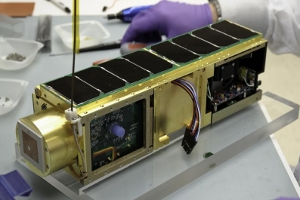 The O/OREOS nanosatellite with one solar panel removed, exposing the electronics and the two science experiment compartments. (Credit: NASA/Dominic Hart)
The O/OREOS nanosatellite with one solar panel removed, exposing the electronics and the two science experiment compartments. (Credit: NASA/Dominic Hart)
To streamline their construction, the majority of these satellites feature a cube-shaped design, a standard that was developed in 1999 by Bob Twiggs, an engineering professor at Stanford University in Palo Alto, and Jordi Puig-Suari at California State Polytechnic University in San Luis Obispo.
“I went and looked for something that would resemble what this satellite would be and I bought a four-inch box. And those four-inch boxes were actually for beanie babies,” said Bob Twiggs in a 2009 interview with KQED Public Radio. His prototype for the ‘CubeSat’ led to an open-source blueprint that any university can follow to build a nanosatellite that can easily be mounted onto a rocket or larger satellite.
A nanosatellite is between two and 22 pounds. While that sounds small, there is actually a smaller class of satellites – picosatellites – that weigh less than two pounds. In comparison, a typical NASA satellite weighs several thousand pounds and can be the size of a school bus.
Since 2000, engineering students at Stanford’s Space and Systems Development Lab have built four nanosatellites, including one that NASA’s Jet Propulsion Laboratory hopes to launch to test a new radio transponder device. Talks between Twiggs and John Hines, a NASA Ames official, also sparked the idea to use for the first time nanosatellites to do biological experiments in space. GeneSat, which launched in 2006, was the first such mission, allowing scientists to monitor the growth rates and gene expression of E. coli bacteria in space.
With Friday’s launch, known as the “Organism/Organic Exposure to Orbital Stresses” mission, or “O/OREOS” for short, scientists at NASA Ames hope to build on what they learned from GeneSat to further push the limits of nanosatellites.
“The primary goal is to show that the technology works and that we have the tools that enable us to do new science. And if we get new science out of it, that is a huge bonus,” said Tony Ricco, the instrument technologist on the O/OREOS mission and a former director of the National Center for Space Biological Technologies at Stanford University.
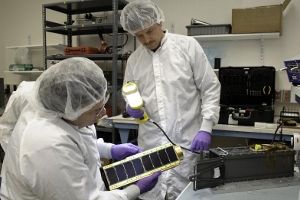 NASA engineers inspect the O/OREOS spacecraft’s interface with the satellite deployment system. (Credit: NASA/Dominic Hart)
NASA engineers inspect the O/OREOS spacecraft’s interface with the satellite deployment system. (Credit: NASA/Dominic Hart)
The O/OREOS satellite consists of three aluminum cubes fused together. One compartment serves as the brains, with lithium-ion batteries, a computer chip microprocessor and a $350 wireless radio found in a household phone to communicate with the satellite. The other two compartments contain live, biological samples and organic molecules that will be subjected to high-energy charged particles, gamma rays, UV light rays and the temperature extremes of space.
The bacteria and biological molecules will be subjected to 75,000 times more radiation than a person is exposed to on a six-hour transatlantic flight. “It’s almost impossible to replicate that space environment on Earth,” said Yost.
It’s also the first time two independent science experiments will be conducted in space aboard a nanosatellite traveling at such a high orbit, 400 miles above Earth’s surface.
One of the experiments contains two kinds of bacteria, including one commonly found in dirt.
“The key thing with it is that it is capable of forming a hard outer shell coating around it, which allows it to survive in harsh environments, like droughts. That’s why it was chosen - to see if bacteria could be transported between planets on meteorites,” said Yost.
The second experiment will monitor the degradation and change of four classes of organic molecules, including an amino acid and another molecule, iron porphyrin, which is similar to the oxygen-carrying protein in human blood.
“We picked that because it’s a biologically relevant molecule. It is a sign that there could be life out there,” said Ricco. “If we had a space mission that went to an asteroid that was in the vicinity of Earth, and we found a porphyrin compound, how long could it have been there? The idea is to figure out what the lifetime of those molecules is and as they degrade, what else they become.”
As the bacteria feed on a nutrient solution, an on-board detector will measure the rate of growth and death in the bacteria for six months and beam the data down to the mission control center at Santa Clara University.
But don’t expect to find a room full of grizzled NASA astrophysicists and engineers pecking away at keyboards and barking commands. The mission control team consists of two dozen graduate and undergraduate engineering students in the robotics lab of mechanical engineering professor Chris Kitts.
“Our students are sending the commands to the satellites, looking at the data, doing the analysis on the data and handing it to the science team,” said Kitts. “And all the equipment that we use to do this is student developed, including the communication stations and the software to track and communicate with the satellite.”
Kitts and his students have worked on NASA Ames nanosatellite missions since 2004.
“There are a few other universities that do portions of operations with NASA, but we provide all the ground infrastructure and communication stations,” he said. “We are the only university in the country that does the entire mission operations on a NASA mission and to have it be student-run is amazing.”
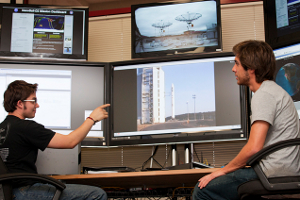 Students at the mission control center at Santa Clara University. (Credit: Mike Rasay)
Students at the mission control center at Santa Clara University. (Credit: Mike Rasay)
The students receive academic credit for their involvement in the missions and a rare opportunity for real-world flight experience on a NASA mission. Four of Kitts’ former students have gone on to work at NASA Ames.
Cost is another driver for NASA to contract out mission control work to Santa Clara University. The amount of money Santa Clara University has received from NASA Ames to oversee the mission operations is less than the salary of one full-time NASA mission control engineer. By working with the university, NASA Ames enjoys access to SCU’s equipment, software and a staff of dozens of bright, motivated students.
“How do we do this even better in the future?” said Yost. “By working with them, we have a way to understand the next generation of systems, and we can tap into all this brain power over there.”
Laura Bica is a senior at Santa Clara University who has been working on the mission since the summer. She is writing software that will allow amateur astronomers and ham radio enthusiasts to track the tiny satellite and to share data with the mission control crew on its solar panel activity, battery power and other facets. The public’s involvement means that the students can maximize the amount of data that is sent via radio signals from the O/OREOS spacecraft as it orbits Earth.
Bica said the mission offers her an exciting opportunity to leapfrog from the walls of academia to the infinite expanse of space.
“Now I can apply my major on a much bigger scale and do work that people all over the world can see,” she said. “Being involved in the robotics lab and this project has opened my eyes to different applications of computer engineering.”
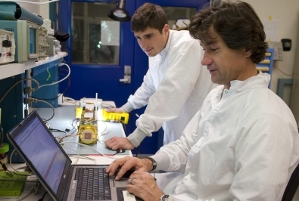 NASA engineers perform software tests to simulate the O/OREOS mission. (Credit: NASA/Dominic Hart)
NASA engineers perform software tests to simulate the O/OREOS mission. (Credit: NASA/Dominic Hart)
Despite their small size, nanosatellites can do more than science experiments with live biological samples. According to Ricco, nanosatellites can be used for telecommunications, to study the upper part of Earth’s atmosphere, to conduct astronomy experiments and even to image coral reefs.
And although these small satellites offer big potential despite their diminutive size, their larger, more robust counterparts still will remain in high demand.
“They won't replace the larger satellites,” said Ricco. “There are science experiments and missions that require a large volume and a large mass to do what needs to be done. But the clever way to do it is to be aware of platforms of all sizes and understand the small satellites and use them where they make sense.”
Nonetheless, NASA officials view nanosatellites as an increasingly important way to get to space cheaper, faster and tackle fundamental questions about the origins of life in the universe.
“In 10 to 20 years, I see frequent and routine access to space for nanosatellites performing on levels we only see in large satellites or ground based systems today,” said Jason Crusan of the NASA Space Operations Mission Directorate in Washington, D.C.
In 2011 the trend will continue. NASA Ames plans to launch MisST, a nanosatellite that will send even more complex living organisms into space – tiny roundworms – and beam microscope pictures of them down to Earth.
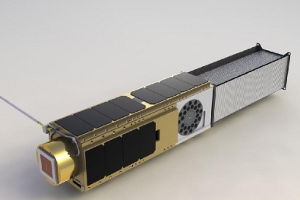 A computer-generated image of the O/OREOS nanosatellite. (Credit: NASA Ames Research Center)
A computer-generated image of the O/OREOS nanosatellite. (Credit: NASA Ames Research Center)



